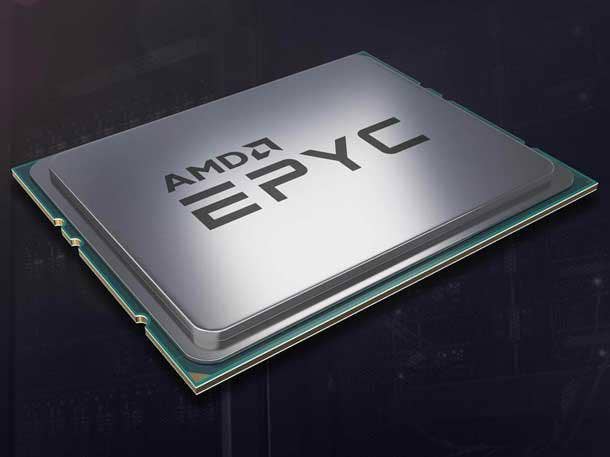AMD Says New EPYC CPUs Best Intel At Energy Efficiency For Edge And Cloud
The chip designer views the new EPYC server CPUs as a good fit for ‘intelligent edge’ use cases for retail, manufacturing, telecommunications and other industries that can benefit from processing data locally using less energy than traditional server processors.

AMD is taking the same architecture it’s using to fight Arm’s rise in the cloud to challenge Intel with a new line of energy-efficient EPYC CPUs for edge and cloud applications.
The Santa Clara, Calif.-based chip designer announced on Monday the launch of its EPYC 8004 series, the last addition to its fourth-generation EPYC family of “workload-optimized” server CPUs that now cover everything from general-purpose and high-performance computing to cloud and edge computing.
[Related: Lisa Su On How AMD Is Building ‘Workload-Optimized’ CPUs]
The company views the new single-socket EPYC CPUs, previously code-named Siena, as a good fit for “intelligent edge” use cases for retail, manufacturing, telecommunications and other industries that can benefit from processing data locally using less energy than traditional server processors.
Dell Technologies, Lenovo and Supermicro are among the first server vendors expected to support the new processor series. Microsoft Azure also plans to launch new infrastructure around the new chips, and telecom giant Ericsson excepts to use them to accelerate cloud RAN deployments.
“The new EPYC 8004 Series processors extend AMD leadership in single-socket platforms by offering excellent CPU energy efficiency in a package tuned to meet the needs of space- and power-constrained infrastructure,” said Dan McNamara, general manager of AMD’s server business, in a statement.
EPYC 8004 Series Specifications: Core Count, TDP And More
The processors are based on AMD’s Zen 4c core architecture used in the recently launched cloud-optimized EPYC 97X4 series. Previously code-named Bergamo, the 97X4 series is focused on high-density cloud workloads, thanks to its maximum core count of 128 energy-efficient cores, and it’s meant to challenge Ampere Computing’s high-core-count, Arm-based CPUs and get ahead of Intel’s upcoming cloud-optimized Xeon processors.
With the EPYC 8004 series, AMD brought down the maximum core count to 64—a third less than the top CPUs in the general-purpose EPYC 9004 series—along with the thermal design power. Whereas the three EPYC 97X4 chips range from 112-128 cores and 320-360 watts for TDP, the 8004 series consists of 12 chips that range from eight to 64 cores and 80-200 watts for default TDP.
Select processors from the lineup, denoted with a “P” suffix, can be configured to a lower or higher TDP, with ranges of 70-100 watts for a 90-watt, eight-core part; 120-150 watts for a 125-watt, 16-core part; and 155-225 watts for four processors that range in default TDP from 160-200 watts. Two of these last processors have 64 cores each while the other two have 24 and 32 cores respectively.
As for other specifications, the base frequency ranges from 2 GHz to 2.65 GHz and the boost frequency ranges from 3 GHz to 3.1 GHZ. The chips support up to six channels of DDR5 memory, a maximum memory bandwidth of nearly 1.2 TB, a maximum DDR5 frequency of 4800 MHz and 96 lanes of PCIe 5 connectivity.
How AMD’s EPYC 8004 Series Competes Against Intel
AMD said the decision to tune the EPYC 8004 series for energy efficiency makes the lineup a significant competitor to Xeon processors from Intel that target similar workloads.
For a baseline comparison, AMD said the top chip in the lineup—the 64-core, 200-watt EPYC 8534P—provides up to two times better performance per system watt than Intel’s 52-core, 300-watt Xeon Platinum 8471N based on a SPECpower benchmark.
For a video encoding workloads, that same AMD chip provides up to 2.4 times more aggregate frames per hour per system watt against the same Intel chip, according to AMD.
In an 8-kilowatt rack of IoT edge gateways, AMD said its eight-core EPYC 8024P can provide up to 80 percent higher throughput performance for the Apache IoTDB database workload than Intel’s eight-core Xeon Bronze 3408U based on a comparison that has similar configurations.
Beyond providing better performance and performance-per-watt, the new EPYC 8004 series can “potentially save customers thousands of dollars in energy costs, with better core density and more throughput,” according to AMD.
This claim was based on a comparison between two single-socket servers, one with the EPYC 8534PN and the other with the Xeon Platinum 8471N. It relied on a few key assumptions, such as a power per rack of 8 kilowatts for servers and a server rack size of 42RU.
With these assumptions, AMD said single-socket servers with the EPYC CPU in one-, three- and 10-node configurations will use 34 percent less power and cost 34 percent less than single-socker servers using Intel’s Xeon processor over a five-year period.
To maximize power utilization in an 8-kilowatt rack, AMD can do so with 26 servers while providing 32 percent faster integer performance than an Intel-based solution with 17 servers, according to AMD.